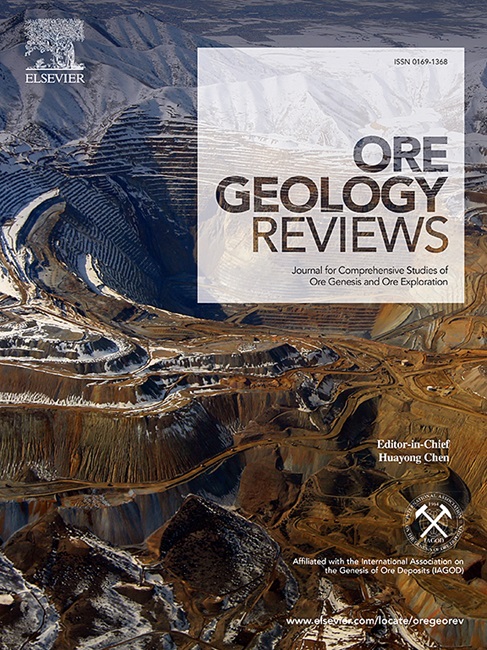Magmatic characteristics and oxygen fugacity variations in the Eocene Yulong porphyry copper belt
IF 3.2
2区 地球科学
Q1 GEOLOGY
引用次数: 0
Abstract
The Yulong porphyry copper belt (YPCB) is characterized by collisional porphyry deposits with varying scales of mineralization and elemental compositions that exhibit a north-to-south gradient. However the factors controlling the diversity of mineralization within the YPCB remain unclear. Oxygen fugacity is a critical factor in porphyry mineralization, significantly influenced by magma crystallization differentiation and fluid saturation during the evolution of porphyry magmas. Accurately assessing the oxygen fugacity of the magma is essential for a comprehensive evaluation of its mineralization characteristics. This study focuses on a range of porphyry deposits within the YPCB, including the small Hengxingcuo Cu–Mo deposit, the superlarge Yulong Cu–Mo deposit, the medium Zhanaga and Mangzong Cu–Mo deposits, the medium Mamupu Cu–Au deposit, and the large Bada Cu–Au deposit, arranged from north to south. This study integrates recent whole-rock geochemical analyses, Sr-Nd isotopic measurements, zircon U–Pb dating, trace element data, and electron probe microanalysis (EPMA) of hornblende to (1) explore the origin and evolution of porphyritic magma with varying metallogenic characteristics, (2) constrain the variations in magma oxygen fugacity and their impact on metal enrichment. Our findings indicate that the mineralized porphyries in the YPCB belong to high-K calc-alkaline to shoshonite series, with elevated Sr/Y (27.69–224.87) and (La/Yb)N (11.29–68.56) ratios, most of which are classfied as adakitic magmas. The analyzed mineralized porphyries display (87Sr/86Sr)i values ranging from 0.7060 to 0.7073 and ƐNd(t) values between −3.8 and −1.0, positioning them above the mixing line of the depleted asthenospheric mantle (MORB) and enriched mantle EMⅡ. These mineralized porphyries in the YPCB are derived from similar source regions, where potassium-rich magmas form through partial melting of the enriched mantle EMⅡ, interacting with adakitic magmas generated from the melting of the lower crust. This interaction leads to the formation of high-potassium adakitic magmas within the belt, while the magma source region undergoes metasomatism from fluids and melts derived from subducted slabs. Oxygen fugacity calculations for zircon and hornblende in the fertile porphyries of the YPCB suggest that relatively high oxygen fugacity is advantageous for mineralization. However, an increase in oxygen fugacity does not always correspond to larger scales of mineralization. By comparing the oxygen fugacity of magma at different stages of evolution in individual ore deposits, it is observed that as the magmas evolve, oxygen fugacity tends to increase, potentially due to the release of fluids during magma differentiation.

求助全文
约1分钟内获得全文
求助全文
来源期刊

Ore Geology Reviews
地学-地质学
CiteScore
6.50
自引率
27.30%
发文量
546
审稿时长
22.9 weeks
期刊介绍:
Ore Geology Reviews aims to familiarize all earth scientists with recent advances in a number of interconnected disciplines related to the study of, and search for, ore deposits. The reviews range from brief to longer contributions, but the journal preferentially publishes manuscripts that fill the niche between the commonly shorter journal articles and the comprehensive book coverages, and thus has a special appeal to many authors and readers.
 求助内容:
求助内容: 应助结果提醒方式:
应助结果提醒方式:


